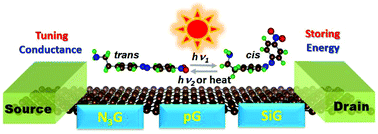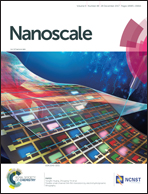A light-driven modulation of electric conductance through the adsorption of azobenzene onto silicon-doped- and pyridine-like N3-vacancy graphene†
Abstract
The ability to modulate the conductance of an electronic device under light irradiation is crucial to the practical applications of nanoscale electronics. Density functional theory calculations predict that the conductance of the photo-responsive graphene-based nanocomposites can be tuned through the noncovalent adsorption of an azobenzene (AB) derivative onto pristine, Si-doped, and pyridine-like N3-vacancy graphene. AB@graphene systems were found to exhibit a visible-light response within the low-frequency region, rendering the trans-to-cis isomerizations of these nanocomposites under the irradiation of solar light. The excellent solar light absorption performances of these hybrids can then be used to modulate the conductance of both N3-vacancy- and Si-doped-graphene AB hybrids effectively through the reversible change of the effective conjugate length of the AB molecule in the photoisomerization. In addition, the solar thermal energy up to 1.53 eV per AB molecule can be stored in the designed nanocomposites with the doped graphene. These findings provide clues for making multifunctional materials with potential applications as both optically controlled nanoelectronics and solar energy storage devices.



 Please wait while we load your content...
Please wait while we load your content...